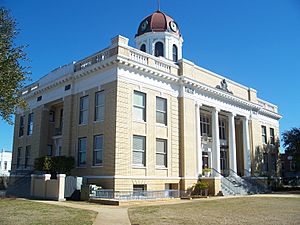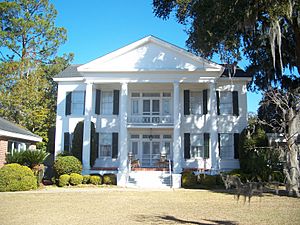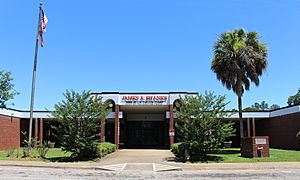Quincy, Florida facts for kids
Quick facts for kids
Quincy, Florida
|
|
|---|---|
| City of Quincy | |
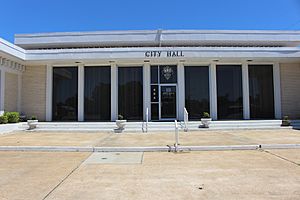
Quincy City Hall
|
|
| Motto(s):
"...In the heart of Florida's future"
|
|
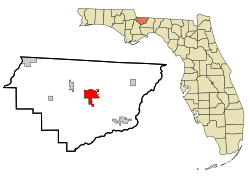
Location in Gadsden County and the state of Florida
|
|
| Country | United States of America |
| State | Florida |
| County | Gadsden |
| Incorporated | 1828 |
| Government | |
| • Type | Commission-Manager |
| Area | |
| • City | 11.65 sq mi (30.17 km2) |
| • Land | 11.65 sq mi (30.17 km2) |
| • Water | 0.00 sq mi (0.00 km2) |
| • Urban | 6.15 sq mi (15.93 km2) |
| Elevation | 207 ft (63 m) |
| Population
(2020)
|
|
| • City | 7,970 |
| • Density | 684.18/sq mi (264.16/km2) |
| • Urban | 8,541 |
| • Urban density | 1,387.80/sq mi (536.16/km2) |
| Time zone | UTC-5 (Eastern (EST)) |
| • Summer (DST) | UTC-4 (EDT) |
| ZIP codes |
32351-32353
|
| Area code(s) | 850 |
| FIPS code | 12-59325 |
| GNIS feature ID | 0289404 |
Quincy is a city in Florida, United States. It is the main city, or county seat, of Gadsden County, Florida. Quincy is also part of the larger Tallahassee, Florida Metropolitan Statistical Area.
In 2020, about 7,970 people lived in Quincy. This number is very close to the 7,972 people who lived there in 2010.
Contents
History of Quincy
Quincy was founded in 1828. It was named after John Quincy Adams, who was a U.S. President. The city is located about 25 miles northwest of Tallahassee, the state capital.
For a long time, Quincy relied a lot on farming. People grew crops like tomatoes, tobacco, mushrooms, and soybeans.
Tobacco Farming in Quincy
In 1828, Governor William P. Duval brought Cuban tobacco to Florida. This led to a big change in Gadsden County. Growing a special kind of tobacco, used for cigar wrappers, became very important for the area's economy and way of life.
Native Americans had been growing tobacco for a long time before Europeans arrived. In 1829, a man named John Smith moved to Gadsden County. He brought tobacco seeds from Virginia. He planted them and found they grew very well.
Over time, his Virginia tobacco mixed with Cuban tobacco seeds. This created a new plant called "Florida Wrapper." This new tobacco was thinner and lighter in color. It started a tobacco industry when other crops like cotton were not doing well.
Growing tobacco was profitable until the Civil War began in 1861. During the war and the time after, called the Reconstruction Era, not much tobacco was grown. Recovery was slow.
After the war, people looked for new ways to make money. They found that light-colored, silky tobacco sold for the best prices. So, they started experimenting with shading the plants. At first, they used wood slats, then cheesecloth, and finally a special yellow cloth by 1950. This cloth provided perfect shade for the tobacco plants.
A railroad president, Colonel Henry DuVal, sent samples of Gadsden County tobacco to New York. Soon, companies came to Quincy to buy land and grow tobacco. Many packing houses were built.
However, around 1970, the demand for tobacco dropped. New types of cigar wrappers were developed, and growing tobacco became more expensive. The last crop of shade-grown cigar wrapper tobacco in Gadsden County was in 1977.
After tobacco, Quincy focused on other crops like tomatoes and mushrooms. It also had egg farms. But after the mushroom factory closed and many workers were laid off from the tomato farm in 2008, Quincy started to focus on building other types of businesses.
Fighting for Fairness
During a time when people of different races were kept separate by laws (called segregation), people in Quincy protested for equal rights. They stood up against unfair treatment.
All-American City Award
In 1996, Quincy was honored as an "All-American City." This award recognizes communities that work together to solve problems and improve local life.
Geography and Climate
Quincy is located in the middle of Gadsden County, Florida. It sits among the rolling hills of North Florida. The city's exact location is 30°35′N 84°35′W / 30.583°N 84.583°W.
U.S. Route 90 is the main road that goes through Quincy. It connects the city to Tallahassee (about 24 miles southeast) and Chattahoochee (about 19 miles northwest). Interstate 10 also passes about 3 miles south of the city center. This highway goes east to Tallahassee and west to Pensacola.
Other important roads in Quincy include SR 12, SR 267, and SR 268.
The city covers a total area of about 11.65 square miles (30.17 square kilometers). Most of this area is land, with very little water.
Quincy's Weather
| Climate data for Quincy | |||||||||||||
|---|---|---|---|---|---|---|---|---|---|---|---|---|---|
| Month | Jan | Feb | Mar | Apr | May | Jun | Jul | Aug | Sep | Oct | Nov | Dec | Year |
| Mean daily maximum °F (°C) | 64 (18) |
67 (19) |
74 (23) |
79 (26) |
86 (30) |
90 (32) |
91 (33) |
90 (32) |
88 (31) |
81 (27) |
73 (23) |
66 (19) |
79 (26) |
| Mean daily minimum °F (°C) | 40 (4) |
42 (6) |
48 (9) |
52 (11) |
61 (16) |
68 (20) |
71 (22) |
70 (21) |
66 (19) |
57 (14) |
49 (9) |
42 (6) |
56 (13) |
| Average precipitation inches (mm) | 4.80 (122) |
4.92 (125) |
5.86 (149) |
3.68 (93) |
5.04 (128) |
5.92 (150) |
7.36 (187) |
6.78 (172) |
4.15 (105) |
4.11 (104) |
3.51 (89) |
3.77 (96) |
59.90 (1,521) |
| Source: Weatherbase | |||||||||||||
Population of Quincy
| Historical population | |||
|---|---|---|---|
| Census | Pop. | %± | |
| 1870 | 743 | — | |
| 1880 | 639 | −14.0% | |
| 1890 | 681 | 6.6% | |
| 1900 | 847 | 24.4% | |
| 1910 | 3,204 | 278.3% | |
| 1920 | 3,118 | −2.7% | |
| 1930 | 3,788 | 21.5% | |
| 1940 | 3,888 | 2.6% | |
| 1950 | 6,505 | 67.3% | |
| 1960 | 8,874 | 36.4% | |
| 1970 | 8,334 | −6.1% | |
| 1980 | 8,591 | 3.1% | |
| 1990 | 7,444 | −13.4% | |
| 2000 | 6,982 | −6.2% | |
| 2010 | 7,972 | 14.2% | |
| 2020 | 7,970 | 0.0% | |
| U.S. Decennial Census | |||
Population Changes (2010 and 2020)
| Race / Ethnicity (NH = Non-Hispanic) | Pop 2000 | Pop 2010 | Pop 2020 | % 2000 | % 2010 | % 2020 |
|---|---|---|---|---|---|---|
| White (NH) | 1,979 | 1,594 | 1,507 | 28.34% | 20.00% | 18.91% |
| Black or African American (NH) | 4,469 | 5,111 | 4,860 | 64.01% | 64.11% | 60.98% |
| Native American or Alaska Native (NH) | 10 | 24 | 5 | 0.14% | 0.30% | 0.06% |
| Asian (NH) | 16 | 52 | 34 | 0.23% | 0.65% | 0.43% |
| Pacific Islander or Native Hawaiian (NH) | 0 | 0 | 0 | 0.00% | 0.00% | 0.00% |
| Some other race (NH) | 0 | 17 | 19 | 0.00% | 0.21% | 0.24% |
| Two or more races or Multiracial (NH) | 27 | 66 | 123 | 0.39% | 0.83% | 1.54% |
| Hispanic or Latino (any race) | 481 | 1,108 | 1,422 | 6.89% | 13.90% | 17.84% |
| Total | 6,982 | 7,972 | 7,970 | 100.00% | 100.00% | 100.00% |
In 2020, Quincy had 7,970 residents. There were 2,642 households and 1,728 families.
About 27.8% of the people were under 18 years old. About 13.8% were 65 years or older. Almost half of the population (49.5%) was female.
The average value of homes owned by residents was $78,600. The average rent was $681 per month. Most households (76.3%) had a computer, and more than half (54.7%) had high-speed internet.
About 72.1% of adults aged 25 and older had finished high school. About 16.9% of adults had a bachelor's degree or higher. The average household income was $31,756.
Arts and Culture in Quincy
Many places in Quincy are listed on the National Register of Historic Places. Most of these are found within the Quincy Historic District. Some of these historic buildings include:
- E. B. Shelfer House
- E. C. Love House
- John Lee McFarlin House
- Judge P. W. White House
- Old Philadelphia Presbyterian Church
- Quincy Library
- Quincy Woman's Club
- Stockton-Curry House
- Willoughby Gregory House
The Gadsden Arts Center is a museum located in a renovated old hardware store. It shows art from the region and from across the country. It also has a special collection of "Vernacular Art," which is art made by ordinary people.
The Leaf Theater is another notable place. It is a historic movie theater and is even said to be haunted!
The North Florida Research and Education Center is in Quincy. The Florida A&M Research and Extension Center is also located nearby.
Local Media
Quincy has two local newspapers that cover news for all of Gadsden County. These are The Gadsden County Times and The Herald, which is based in Havana.
Education in Quincy
The Gadsden County School District manages the public schools in the area. Some of the schools include:
- Carter-Parramore Academy School
- Chattahoochee Elementary School
- Crossroad Academy Charter School
- Gadsden Central Academy School
- Gadsden County High School
- Gadsden Elementary Magnet School
- Gadsden Technical Institute School
- George W. Munroe Elementary School
- Greensboro Elementary School
- Havana Magnet School
- James A. Shanks Middle School
- Stewart Street Elementary School
- West Gadsden Middle School
In 2003, James A. Shanks High School in Quincy and Havana Northside High School joined together to form East Gadsden High School. By 2017, East Gadsden High became the only public high school in the county.
Robert F. Munroe Day School is a private school for students from kindergarten to 12th grade. Its kindergarten campus is in Quincy, while the main campus is in Mount Pleasant.
The William A. "Bill" McGill Public Library is part of the Gadsden County Public Library system.
Transportation
Roads and Highways
U.S. Route 90 (Jefferson Street) is the main highway in Quincy. It connects to Tallahassee to the southeast and Chattahoochee to the northwest. Interstate 10 is also close by, about 3 miles south of the city. I-10 leads to Tallahassee in the east and Pensacola in the west.
Other important roads in Quincy include SR 12, SR 267, and SR 268.
Public Transportation
Big Bend Transit provides shuttle-bus and van services. These connect Quincy with nearby towns like Chattahoochee, Havana, and Tallahassee.
Railroad Service
Freight trains are operated by the Florida Gulf & Atlantic Railroad. This company took over a major rail line in 2019.
Airport
Quincy Municipal Airport is a public airport. It is located about 2 miles northeast of the city center.
Quincy and Coca-Cola
Investors from Quincy played a big part in helping the local Coca-Cola company grow into a huge global business. It's even said that Quincy was once home to many millionaires because of the Coca-Cola boom!
A local banker named Mark Welch “Mr Pat” Munroe, along with W.C. Bradley, were among those who encouraged people to invest in Coca-Cola stock. They told farmers and widows to buy shares for $40 each. Many people did, and those investments grew a lot over time.
If someone had bought just one share of Coca-Cola stock for $40 in 1919 and reinvested all the money they earned from it, that single share would be worth about $6.4 million today! This made many people in Gadsden County very rich.
Notable People from Quincy
- Nat Adderley Jr. (born 1955), a music arranger who worked with Luther Vandross.
- Elizabeth Whitfield Croom Bellamy (1837–1900), a writer.
- The Lady Chablis (1957–2016), an entertainer known from the book and movie Midnight in the Garden of Good and Evil.
- Billy Dean (born 1962), a country music singer.
- Freddie Figgers (born 1989), an inventor and business owner in electronics.
- Mack Lee Hill (1940–1965), a football player for the Kansas City Chiefs.
- Willy Holt (1921–2007), a French-American film production designer.
- Dexter Jackson (born 1977), a football player and Super Bowl MVP.
- Jerrie Mock (1925–2014), the first woman to fly solo around the world.
- TeJyrica Robinson (born 1998), an American hurdler.
- Willie Simmons (born 1980), a football coach for the Florida A&M Rattlers football team.
Images for kids
See also
 In Spanish: Quincy (Florida) para niños
In Spanish: Quincy (Florida) para niños



